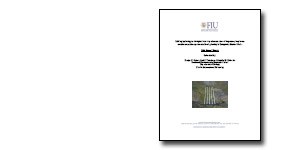|
CESI >> Program Areas & Projects >> Baseline Research >> Current Page

Photo Courtesy of Joel Trexler The effects of nutrient enrichment in the Florida Everglades are of considerable concern with regards to ecosystem restoration. The famed River of Grass is widely thought to have been a historically nutrient-poor environment. Today, however, the Everglades are subject to higher levels of enrichment from a variety of sources. This five-year study involved constructing large-scale experimental phosphorus dosing stations in Everglades National Park. During the project period, ecosystem parameters were carefully monitored in response to specific concentrations up to 30 parts per billion (ppb). The study documented substantial changes in both periphyton and aquatic plant communities, and provides valuable insight into the recovery of marsh systems in the absence of continued enrichment. FOR DOWNLOAD 
This 2004 Annual Report is comprised primarily of articles published in third-party, peer-reviewed journals. Please look below to find citations for related publications. RELATED PUBLICATIONS Gaiser, E., J. Richards, J. Trexler, R. Jones and D. Childers. 2006. Periphyton responses to eutrophication in the Florida Everglades: Cross-system patterns of structural and compositional change. Limnology and Oceanography 51(2): 617-630 Gaiser, E. E., J. Trexler, J. Richards, D. Childers, D. Lee, A. L. Edwards, L. Scinto, K. Jayachandran, G. Noe and R. Jones. 2005. Cascading ecological effects of low-level phosphorus enrichment in the Florida Everglades. Journal of Environmental Quality 34: 403-407. Gaiser, E. E., L. J. Scinto, J. H. Richards, K. Jayachandran, D. L. Childers, J. D. Trexler and R. D. Jones. 2004. Phosphorus in periphyton mats provides best metric for detecting lowlevel P enrichment in an oligotrophic wetland. Water Research 38: 507-516. Contact the principal investigator directly with questions about this study, |
Last updated: October 3, 2018

